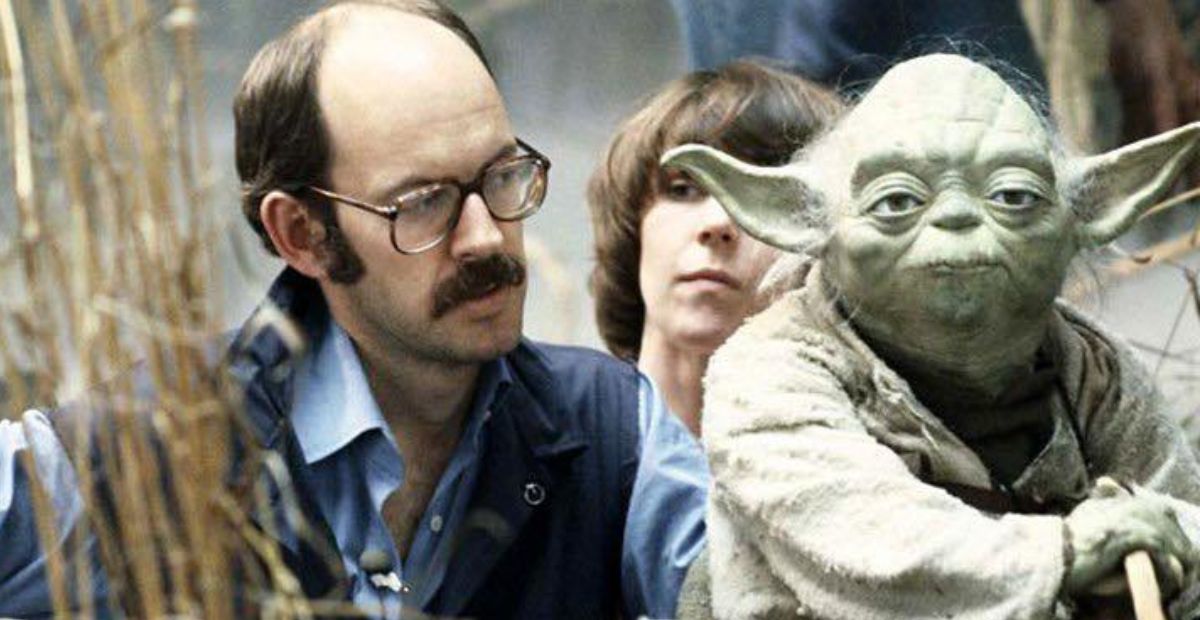Think you know Yoda? You’ve seen him lift X-wings and lecture Skywalkers, but you probably haven’t heard about the monkey in a mask, the Einstein eyebrows, or George Lucas’s failed Oscar campaign.
Let’s look at 4 surprising behind-the-scenes facts about the Yoda puppets that made movie history.
1. Yoda’s Wisdom Comes From Freeborn’s Face and Einstein’s Eyes
Look at Yoda’s eyes and brow with me for a second. See that soft, thoughtful sag and those fine creases at the corners? That’s creature designer Stuart Freeborn building from a face he knew, his own, and then borrowing cues from Albert Einstein to make “aged wisdom” read instantly on camera. He even summed it up himself: “half me and half Einstein, with all the wrinkles.”
Because Empire lives in close-ups on Dagobah. The gently hooded lids, the weight in the brow, and the etched crow’s-feet give puppeteers precise “targets” they can play. A millimeter of eyelid drop can read as doubt; a tiny brow lift can read as curiosity. Instead of rubber just moving, your brain reads thought.
Try this on your next rewatch: focus only on the upper eyelids when Yoda shifts from playful to serious. That tiny change lands like a change of mind. In wider shots, the crow’s-feet and brow do the heavy lifting so expression still plays from a distance—no exaggerated mouth shapes needed.
There’s a bit of production reality baked in, too. The team was racing the clock to get Yoda ready, and Freeborn later joked, “I’ve never modelled anything so quick.” That time pressure pushed the design toward clean, readable planes and human reference rather than abstract “alien” noise. Result: a face the camera believes at whisper distance.
2. The Team Briefly Considered a Monkey in a Mask (and Ditched It)
Before Yoda became a full puppet, the crew actually tested the notion of using a trained monkey in a Yoda mask (plus a cane). It sounds clever until you remember close-ups: you can’t direct eyelids, micro-blinks, or a thoughtful brow on cue with an animal. That’s the whole performance Yoda needs.
The plan fell apart for exactly the reason you’re imagining. As author J.W. Rinzler documented, one veteran warned, “The monkey’s just going to pull the mask off over and over again. It’s never going to work.”
Once that idea was shelved, the team committed to a purpose-built puppet. Jim Henson consulted and pointed them to Frank Oz, whose lead performance could be synchronized with dedicated controls for eyes, lids, ears, and mouth. To make that work on set, the Dagobah hut was built on a raised platform so puppeteers could operate from below and hit consistent eyelines. That pivot gave the filmmakers precise, repeatable facial acting in tight frames—the thing the mask test couldn’t deliver.
3. George Lucas tried to get Frank Oz an Oscar nod for Yoda
In the aftermath of The Empire Strikes Back, George Lucas pressed for Frank Oz to be considered for Best Supporting Actor, a recognition aimed at the totality of the performance on Dagobah: voice, timing, and the coordinated facial work built around Oz’s lead. The push ran into a wall. At the time, Academy voters weren’t prepared to classify puppetry as “on-screen acting,” and the campaign went nowhere. As a snapshot of 1980 industry thinking, it’s stark: a landmark character could anchor dialogue scenes and shape the film’s tone, yet the system had no obvious way to honor the work behind it.
4. The Phantom Menace’s Puppet Yoda Was Later Replaced With CG in 2011
The Phantom Menace opened in 1999 with a physical Yoda puppet—lit and shot for dialogue on the Jedi Council set, with a couple of wide digital shots elsewhere. A dozen years later, the 2011 Blu-ray standardized the character across the prequels: the puppet was replaced throughout with a CG model that matched the proportions, surface detail, and motion style established in Attack of the Clones and Revenge of the Sith. Line up the Council scenes and the shift is immediate—the 2011 Yoda sits lower in the face, reads cleaner under the lights, and moves in step with the later films, closing a visual gap that had lingered since 1999.
5. Frank Oz Was Also the Voice of… Miss Piggy
Yeah, the same dude who said “Do or do not, there is no try” also went “HI-YAH, KERMIT!” — and it’s true. Frank Oz wasn’t just the puppeteer and voice behind Yoda; he also brought life to Miss Piggy, Fozzie Bear, Animal, and countless other Muppets.
That overlap is part of what made Yoda work so well: Oz’s sense of timing and emotional nuance came straight from years of performing characters who were funny, expressive, and deeply human beneath the felt.
It’s wild to think that the man who trained Luke Skywalker on Dagobah also spent decades karate-chopping frogs on The Muppet Show. Frank Oz is an absolute legend.

